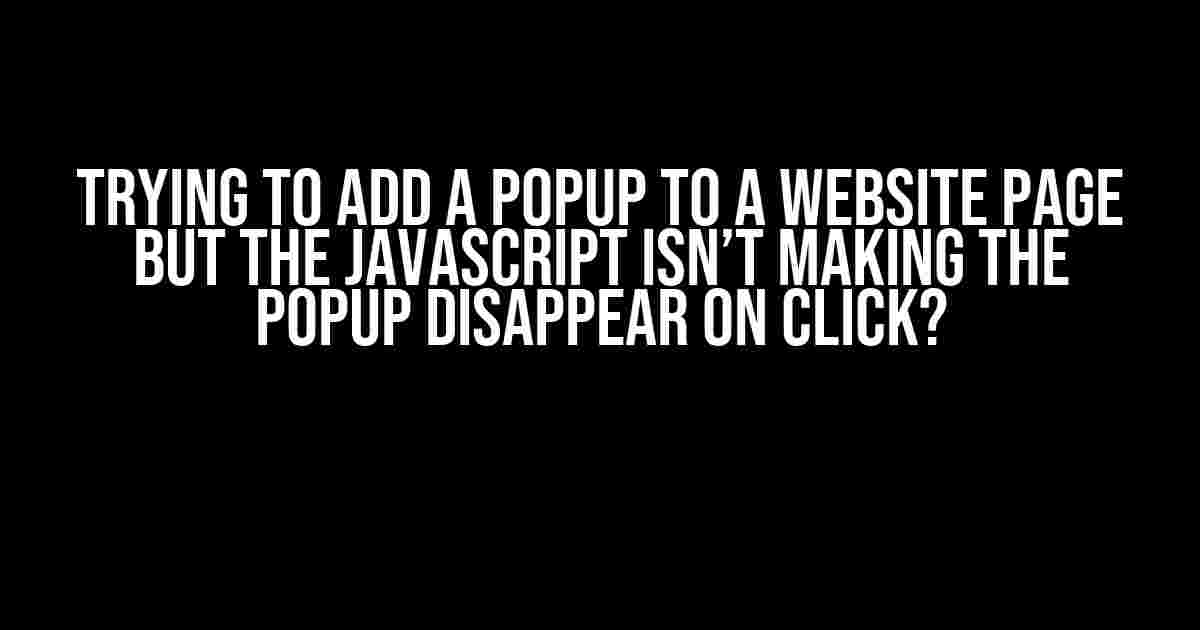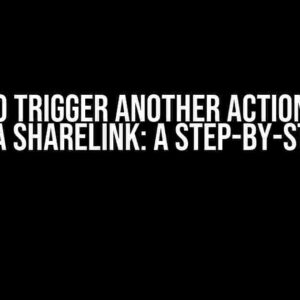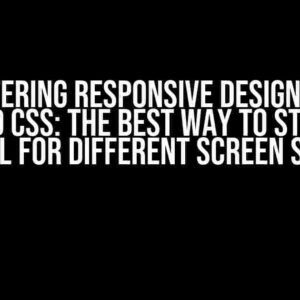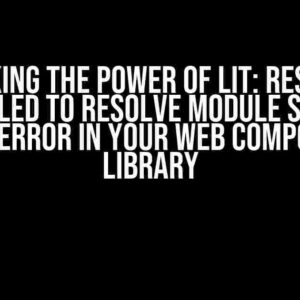Are you frustrated with your popup not disappearing after clicking on it? Well, you’re not alone! Many developers have faced this issue, and today, we’ll explore the solutions to this problem. In this article, we’ll dive into the world of popups,JavaScript, and HTML to get your popup to disappear smoothly.
Understanding the Problem
The issue lies in the JavaScript code that controls the popup’s behavior. When you click on the popup, it should ideally disappear, but sometimes, it just refuses to budge. This can be due to various reasons, including:
- Improperly written JavaScript code
- Incorrect event listeners
- Conflicting CSS styles
- Incompatible browser versions
Let’s Start with the Basics
Before we dive into the solutions, let’s create a basic popup structure using HTML, CSS, and JavaScript. Create a new HTML file and add the following code:
<div class="popup-container">
<div class="popup">
<p>This is a sample popup!</p>
<button id="close-popup">Close</button>
</div>
</div>Next, add some basic CSS to style our popup:
body {
font-family: Arial, sans-serif;
}
.popup-container {
position: fixed;
top: 0;
left: 0;
width: 100%;
height: 100%;
background-color: rgba(0, 0, 0, 0.5);
display: none;
}
.popup {
position: relative;
top: 50%;
left: 50%;
transform: translate(-50%, -50%);
background-color: #fff;
padding: 20px;
border-radius: 10px;
box-shadow: 0 0 10px rgba(0, 0, 0, 0.3);
}
#close-popup {
background-color: #333;
color: #fff;
border: none;
padding: 10px 20px;
font-size: 16px;
cursor: pointer;
}Now, let’s add some JavaScript to make our popup appear and disappear:
<script>
const popupContainer = document.querySelector('.popup-container');
const closePopupBtn = document.getElementById('close-popup');
closePopupBtn.addEventListener('click', () => {
popupContainer.style.display = 'none';
});
</script>The Problem with the Above Code
The above code is a basic implementation, but it has a major flaw – the popup doesn’t disappear when you click on it. This is because we haven’t added an event listener to the popup container itself. When you click on the popup, the event is not propagated to the close button, and hence, the popup remains visible.
Solution 1: Add an Event Listener to the Popup Container
One way to solve this issue is to add an event listener to the popup container. This will capture the click event on the popup and close it:
popupContainer.addEventListener('click', (e) => {
if (e.target === popupContainer) {
popupContainer.style.display = 'none';
}
});This code adds an event listener to the popup container, and when you click on it, it checks if the target element is the popup container itself. If it is, it sets the display property to none, effectively hiding the popup.
Solution 2: Use the `stopPropagation()` Method
Another solution is to use the `stopPropagation()` method to prevent the event from bubbling up to the popup container. This way, when you click on the close button, the event is stopped from propagating, and the popup disappears:
closePopupBtn.addEventListener('click', (e) => {
e.stopPropagation();
popupContainer.style.display = 'none';
});This code stops the event from propagating up the DOM tree, ensuring that the popup container’s event listener is not triggered, and the popup disappears as expected.
Solution 3: Use a Delegate Event Listener
A more elegant solution is to use a delegate event listener. This involves adding an event listener to a parent element (in this case, the body) and checking the target element to determine which action to take:
document.body.addEventListener('click', (e) => {
if (e.target === closePopupBtn || e.target === popupContainer) {
popupContainer.style.display = 'none';
}
});This code adds an event listener to the body element and checks if the target element is either the close button or the popup container. If it is, it hides the popup.
Common Issues and Troubleshooting
Even with the above solutions, you might still encounter some issues. Here are some common problems and their solutions:
Issue 1: Popup Doesn’t Disappear in Certain Browsers
Sometimes, the popup might not disappear in certain browsers, especially older versions. This can be due to compatibility issues with the `stopPropagation()` method or other JavaScript features.
Solution: Use a fallback solution, such as adding a timer to hide the popup after a certain delay:
setTimeout(() => {
popupContainer.style.display = 'none';
}, 500);Issue 2: Popup Disappears Too Quickly
If the popup disappears too quickly, it can be frustrating for users. This issue can occur due to the event listener being triggered too soon.
Solution: Add a delay to the event listener using `setTimeout()`:
closePopupBtn.addEventListener('click', () => {
setTimeout(() => {
popupContainer.style.display = 'none';
}, 500);
});Conclusion
In this article, we’ve explored the world of popups, JavaScript, and HTML to solve the issue of a popup not disappearing on click. We’ve discussed three solutions: adding an event listener to the popup container, using the `stopPropagation()` method, and using a delegate event listener. Additionally, we’ve covered common issues and troubleshooting tips to ensure your popup behaves as expected.
Best Practices
To ensure your popup is user-friendly and doesn’t annoy your visitors, follow these best practices:
- Keep your popup simple and concise
- Use a clear and prominent close button
- Avoid using too many popups on a single page
- Make sure your popup is accessible and follows accessibility guidelines
- Test your popup on multiple browsers and devices
Final Thoughts
Adding a popup to your website can be a great way to engage with your users, but it requires careful planning and execution. By following the solutions and best practices outlined in this article, you can create a seamless popup experience that enhances your website’s user experience. Happy coding!
| Solution | Description |
|---|---|
| Add an event listener to the popup container | Captures the click event on the popup container and hides it |
| Use the `stopPropagation()` method | Stops the event from propagating up the DOM tree, ensuring the popup disappears |
| Use a delegate event listener | Adds an event listener to a parent element and checks the target element to determine the action |
We hope this article has helped you solve the issue of your popup not disappearing on click. If you have any further questions or need more assistance, feel free to ask in the comments below!
Frequently Asked Question
Stuck on making that pesky popup disappear? Don’t worry, we’ve got the answers!
Q1: Why isn’t my JavaScript code making the popup disappear on click?
Ah, it’s possible that your JavaScript code is not targeting the correct element or event listener. Double-check that your code is selecting the correct popup element and attaching the click event listener correctly. Also, make sure that the event listener is not being blocked by any other scripts or elements on the page.
Q2: Is there a specific JavaScript method I should be using to make the popup disappear?
Yes, you can use the `remove()` or `hide()` method to make the popup disappear. For example, if you’re using jQuery, you can use `$(‘#popup’).hide()` or `$(‘#popup’).remove()` to hide or remove the popup element respectively. Make sure to replace `#popup` with the actual ID or class of your popup element!
Q3: What if I’m using a CSS Framework like Bootstrap? Do I need to use a specific method to close the popup?
If you’re using Bootstrap, you can use the `hide()` method provided by Bootstrap’s modal component. For example, you can use `$(‘#myModal’).modal(‘hide’)` to hide the popup. Make sure to replace `#myModal` with the actual ID of your modal element!
Q4: What if my popup is not a modal, but a custom HTML element? How do I make it disappear?
In that case, you can use plain old JavaScript to add a click event listener to the popup element and set its `display` property to `none` or `visibility` property to `hidden` when clicked. For example, you can use `document.getElementById(‘popup’).style.display = ‘none’` or `document.getElementById(‘popup’).style.visibility = ‘hidden’`. Boom!
Q5: Are there any common mistakes I should avoid when trying to make a popup disappear?
Oh yeah! Make sure to avoid using ` setTimeout()` to delay the disappearance of the popup, as it can cause issues with the popup not disappearing immediately. Also, avoid using `display: none` and `visibility: hidden` together, as it can cause the popup to not disappear at all! Finally, test your code in different browsers and devices to ensure that it works as expected.




